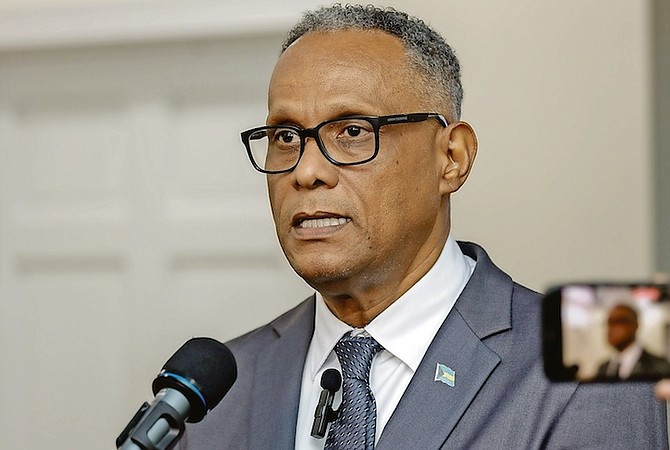By EARYEL BOWLEG
Tribune Staff Reporter
ebowleg@tribunemedia.net
HEALTH and Wellness Minister Dr Michael Darville said The Bahamas has reached the moment where “tremendous progress is being made” and that the “end of the AIDS epidemic is in sight.”.
He revealed that his ministry could report that 95 percent of persons in The Bahamas living with HIV now know their HIV status. Moreover, 73 percent of persons who know their status are on treatment while 81 percent of those on treatment are virally suppressed, which he said is the “gold standard” for HIV care.
The minister highlighted the joint United Nations programme on HIV/AIDS leads and motivates the world to achieve its shared vision of zero new HIV infections, zero discrimination, and zero AIDS-related deaths.
The Tall Pines MP added: “The Bahamas shared those global fast track strategies to end AIDS by the year 2030. The interim targets for the year 2025 includes identifying 95 percent of people living with HIV, placing 95 percent of positively identified individuals on antiviral therapy, ensuring that 95 percent of those on therapy achieve undetectable viral loads indicative of treatment success.”
He gave the data during a press conference on Friday giving a situational update in regard to the fight against AIDS and HIV.
Dr Nikkiah Forbes, director of the National HIV/AIDS and Infectious Disease Programme, explained that the most current data collated will reflect the period to the end of 2021.
The data shows that approximately 4,447 persons were living with HIV at the end of 2021 and that means the HIV prevalence is estimated at 1.3 percent of the population at this time.
Asked if new cases were reported last year, Dr Forbes answered: “So I can tell you what our most recent data is, and that is actually in the year 2019 - there were 133 new HIV infections. This is generally actually, there were no babies born with HIV in the year 2019 and this deferred in the year 2010. There were 285 new HIV cases.”
She said health officials have seen remarkable progress in terms of a decline in the number of new infections. She said that the number of newly reported HIV diagnoses decreased by 53 percent in the years between 2010 and 2019.
“AIDS deaths, that is something that we know is preventable, once people are on effective treatment, and are getting effective care, and that has also decreased by 40 percent, between the years 2010 and 2019. So we are seeing some progress,” she said.
The milestone of diagnosing 94 percent of people who are living with HIV by official estimates was achieved in 2021.
“Further to that 73 percent of people living with HIV who know their status, were on treatment and that was a very high number, the highest numbers we’ve seen currently in our programming. And of those persons who are on treatment 81 percent of persons have achieved viral suppression and that is also increasing,” Dr Forbes said.
“So I can tell you that the number of people living with HIV on treatment has nearly doubled from 2012 to the end of 2021. We had about 1,043 persons on treatment, HIV treatment, in 2013. The treatment guidelines were a little different then and we moved to treating all persons with HIV infection regardless of their illness stage, or whether they were having symptoms. We were one of the first Caribbean countries to do that in 2015 and so the number of persons on treatment in 2021 was about 3,047.”
As for a breakdown on the demographics, the director indicated that women on treatment for HIV have more viral suppression than men right now.
“I think it’s about 80 percent of the women are virally suppressed, 82 percent. And the men are more at about 70 percent,” she said.
Meanwhile, no babies were born with HIV in The Bahamas in the years 2010, 2015, 2019, 2020, and 2021. There was zero percent HIV transmission mother to baby in the last three years in the country.
Hoarding, as it relates to medication, was identified as an issue in The Bahamas.
Dr Forbes explained: “When I mentioned that we really need better partnerships to have one single patient profile, it’s very important, because if someone is coming in who’s living with HIV, and they’re using multiple names, for example.
“They’re using three different names, and then going to three different treatment sites and collecting three times the amount of medication. There can be hoarding in that way and that is something that we have noticed as we tried to have more accurate information and have confidential ways of ensuring that we have one patient profile, like using unique identifier numbers and other information.
“That is something that we have found and there also can be, well, some of our providers collect medications and give it on behalf of the patient. And so there is the potential, for example, if a patient doesn’t pick up medicines, there could be medicines sitting in the offices.”
She emphasised officials have a very important responsibility to make certain that they have enough medications and how hoarding can make managing supplies difficult.





Comments
tribanon 1 year, 7 months ago
Our government has no control over our public health system and Darville, like Davis, must sing whatever tune he is told to sing by our Chinese Communist Masters.
Sign in to comment
Or login with:
OpenID